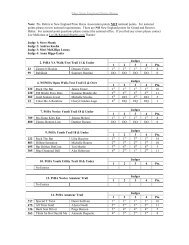2011 Official Rule Book - New England Pinto Horse Association
2011 Official Rule Book - New England Pinto Horse Association
2011 Official Rule Book - New England Pinto Horse Association
You also want an ePaper? Increase the reach of your titles
YUMPU automatically turns print PDFs into web optimized ePapers that Google loves.
REGisTRaTion<br />
1. <strong>Horse</strong> Classification - Must be over 14 hands (56 inches)<br />
at maturity, measured at the withers.<br />
2. Pony Classification - Must be over 38 inches but not<br />
exceeding 14.0 hands (56 inches) at maturity, measured at<br />
the withers.<br />
3. Miniature Classification - Must be 34 inches or under at<br />
maturity, measured at the last hair of the mane.<br />
4. “B” Miniature Classification - Must be over 34 inches but<br />
not exceeding 38 inches, measured at the last hair of the<br />
mane.<br />
5. Utility Classification – Utility animals are classified<br />
as horses regardless of height, no measurement is<br />
required. These horses follow color rules for horses<br />
but have their own outcross breeds. To be registered in<br />
this Classification, the horse must be registered with an<br />
approved outcross breed listed in this <strong>Rule</strong> <strong>Book</strong>.<br />
B. Reclassification By Height<br />
A <strong>Pinto</strong> may be reclassified by height one time only after<br />
reaching the age of five years or at any time said <strong>Pinto</strong><br />
exceeds the maximum height requirement for its respective<br />
division.<br />
1. <strong>Pinto</strong>s registered in the Pony Division that do not exceed<br />
38 inches at maturity may be reclassified into the “B”<br />
Miniature Division.<br />
2. <strong>Pinto</strong>s that change from one division to another (i.e. pony<br />
to miniature or horse to pony) may not change back to<br />
previous division.<br />
C. Measurement of Animals<br />
1. Stand the animal on a smooth, level, solid surface (i.e.,<br />
cement, plywood) in such a position that the front legs are<br />
vertical and the back of the hocks are in a vertical line with<br />
the point of the animal’s hindquarter.<br />
2. The head is to be held low enough to reveal the highest<br />
point of the withers.<br />
3. With the animal in this position, measure the vertical<br />
distance from the highest point of the withers to the<br />
ground.<br />
4. The arm of the measuring standard shall be placed over<br />
the highest point of the withers and no measurement taken<br />
at any other part of the animal’s body shall count, except<br />
with miniatures, which are to be measured at the last hair<br />
of the mane.<br />
5. The standard must be a straight, unbendable stick and<br />
should be provided with a plumb bob or spirit level to make<br />
sure the standard is perpendicular from withers to the<br />
ground and that the crosspiece is parallel with the ground<br />
surface.<br />
6. A Pony may be measured unshod and then shown shod.<br />
The height of shoe does not count in the measurement,<br />
provided the Pony is measured unshod.<br />
7. If a pony is measured shod, the shoes are included in the<br />
total height measurement.<br />
8. Toe And Heel<br />
a. The length of the toe shall be determined by<br />
measuring the front of the hoof in the center from the<br />
skin line on the lower side of the coronary band to<br />
the ground, inclusive of pad and shoe, and exclusive<br />
of airspace caused from extending nail heads on the<br />
bottom of the shoe.<br />
b. Rasping of nail heads is acceptable to provide an<br />
accurate measurement where shoe lies flat on the<br />
ground.<br />
38 <strong>2011</strong> PtHA <strong>Rule</strong> <strong>Book</strong>



